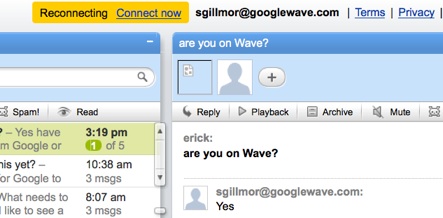 Now that Google Wave is trickling out into the water supply, I’ve been sucked into “playing” with it alongside FriendFeed, Yammer, Skype, and email. Erick Schonfeld insists on discussing a project we’re readying, and unfortunately I’m able to sign in from my iPhone. The FriendFeed direct message interface is not exposed on the iPhone version, and Skype makes me feel stupid for entering a ping and then watching my battery indicator drop while waiting for some signs of life. In this environment Wave suddenly is acceptably lousy.
Now that Google Wave is trickling out into the water supply, I’ve been sucked into “playing” with it alongside FriendFeed, Yammer, Skype, and email. Erick Schonfeld insists on discussing a project we’re readying, and unfortunately I’m able to sign in from my iPhone. The FriendFeed direct message interface is not exposed on the iPhone version, and Skype makes me feel stupid for entering a ping and then watching my battery indicator drop while waiting for some signs of life. In this environment Wave suddenly is acceptably lousy.
I’m down at Oracle’s OpenWorld event, which lands like Normandy on Howard Street with a massive tent that this year has proved helpful in the rainstorm hitting full force. The occasion was Salesforce boss Marc Benioff’s quasi-keynote in a small theater just off the main Moscone hub. I caught up with Marc after the presentation at the Salesforce booth, a massive presence punctuated by a giveaway of two SmartCars or equivalent. As Marc suggested, they were one of three exciting things at this year’s conference.
The first was the strange Scott McNealy/Larry Ellsion co-keynote on Sunday night, a delayed-on-account-of the-EU swan song by McNealy that picked up midsentence from his first take at JavaOne in June. Jonathan Schwartz was nowhere to be seen, though his number 2 John Fowler was given a visible role in the proceedings. Scott seemed determined to thread the needle of continuity with the old Sun vibe, but even Ellison’s rosy words of support for MySQL and IBM badmouthing in favor of Sun hardware did little to alter the truth that Sun survives only in its products but not the ideas that might have been coming.
Ellison made it clear in recent days that he’s still stuck on his who-cares-about-cloud-computing schtick, but Benioff for one thinks he’s missing the obvious. While Oracle allowed Salesforce to team up with Michael Dell in this little alternate conference within a conference, Benioff seemed happy to promote being right about the cloud in the midst of the lion’s den. From my vantage point at the back of the theater, there was a small hemorrhage of attendees when Facebook/Twitter integration with its Call Center and CRM services were demoed. But if 10% left, that meant 90% got a message 180 degrees from the show-wide Oracle Fusion meme, Marc’s third exciting theme.
So it will go with Google Wave, as it begins to penetrate the legacy environements of Gmail, Gchat, and Apps. Right now it’s a red-haired step child of both the cloud and the stream, pretty much useless in both courts. The more that user feedback intrudes, the more Wave will devolve to an email clone. But if Google resists that impulse, something big is likely to happen. This is not about user experience; it’s a war for control of the Google realtime platform, and the central mechansim to slow down Facebook and Twitter. As such, they need to fail, and fail fast — and then start integrating with or absorbing Gmail and Apps.
They can look no further than Yammer for tips; the Twitter enterprise clone has rapidly expanded its rich clients on the desktop and the iPhone to provide push notification at a precisely the time we need it. In particular the iPhone app is suddenly more useful than email, with new messages indicated on the icon as they are received (42 at the moment) and direct messages popping up in a Push notification. Email has too much flow and not enough filtering to avoid constant interruptions by needy PR and the like, and forget about Twitter or even FriendFeed in their current firehose status.
Wave could grab this away from Yammer with little trouble, but the big problem is one of focus. The prize is stream control, the metering of stream dynamics and some sort of pass-off to a stream feed that can be consumed after the high order Yammer-type business flow is absorbed. For now, Wave can co-exist with FriendFeed/Facebook, and ignore Twitter and email. That leaves Skype and Google Docs traffic, which suggests that Gmail and Gchat integrate Waves as a new datatype to be launched into once pressing messages are triaged.
A strategy begins to emerge: high priority messages, Wave document discussion, stream maintenance, and email/presence monitoring. Using the Oracle/Cloud example, start pilot cloud projects, task IT with building hybrid on-premise “private/public” clouds, then negotiate with hosting and virtualization layers as M&A activity drives the move to cloud consolidation.
Wave sucks in its implementation, in its stonewalling of our need for priority stream filtering, in its confusion about its entry point into Google, or vice versa. But that will get sorted out by brute force, more likely by Facebook and FriendFeed integration, and whatever Twitter can buy in house to avoid cannibalization by Track invaders from their increasingly quarantined thrid party vendors. And Microsoft and Apple loom to mop up if Google slips too much or dithers too long, which probably means they won’t Wave may suck, but it won’t matter for long.